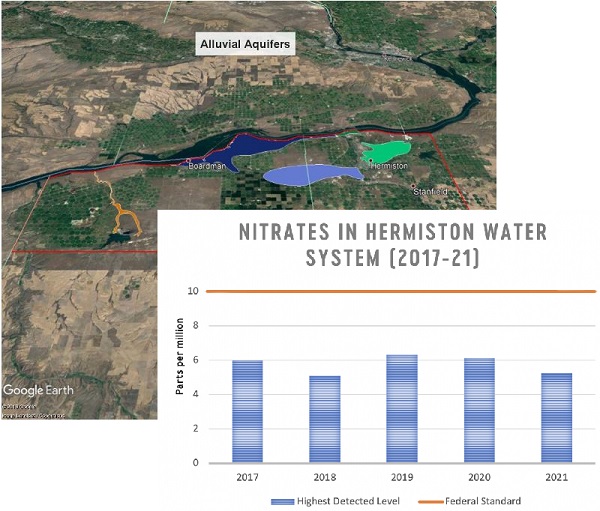Lower Umatilla groundwater gets more nitrate contamination
3 min read
Mixing baby formula with contaminated water can cause blue baby syndrome, death
Hermiston, Ore.—Infants below the age of six months who drink water contaminated with nitrate could become seriously ill, and, if untreated, may die. Symptoms include shortness of breath and blue-baby syndrome.
That risk to human health explains why the Oregon Department of Environmental Quality fined the Lamb Weston potato processing facility in Hermiston $127,800 for overapplying wastewater containing nitrogen to farmland and causing nitrate groundwater contamination in the Lower Umatilla Basin, an area with longstanding groundwater contamination.
Lamb Weston has a DEQ water quality permit that allows it to use the nitrogen-rich wastewater from its potato processing plant and several other facilities to irrigate and fertilize nearby farms. The permit, however, includes limits on how much nitrogen can be applied to each crop. While nitrogen is a beneficial plant nutrient, applying too much to land can contribute to nitrate contamination in groundwater.
Lamb Weston exceeded these limits on 90 different occasions, resulting in approximately 446,990 pounds of excess nitrogen being applied onto the land application sites between 2015-2021. DEQ also cited Lamb Weston for failing to report non-compliance with the permit within five days of the violation, and for a separate spill of almost 25,000 gallons of industrial wastewater to soil.
There are many sources contributing to nitrate contamination in the area, which spans northern Morrow and Umatilla counties. The primary source of contamination in the area (about 70%) is from fertilizer use on irrigated farmland, according to the Lower Umatilla Basin Groundwater Management Area Action Plan. Additional contributors are dairy and cattle farms (about 20%), food processing facilities like the Lamb Weston that reuse wastewater to irrigate fields (about 5%), and residential septic systems and other sources (about 5%).
DEQ ordered Lamb Weston to develop and implement a plan to ensure compliance with the nitrogen limits in the permit and to conduct a remedial investigation of the aquifer under its land application sites.
DEQ discovered the violations while preparing a permit renewal for the facility. DEQ is also working with other industrial facilities in the area to ensure appropriate land application practices that protect the area’s groundwater.
The U.S. Environmental Protection Agency (EPA) has established the safe drinking water standard (also called maximum contaminant level) for nitrate as 10 mg/L as measured nitrogen (NO3-N). If your water has nitrate levels above 10 mg/L, it is advisable to switch to bottled water.
The City of Hermiston reports the drinking water produced by the city is safe, and meets or exceeds all federal and state requirements.
How can nitrate affect my health?
Nitrate is a potential health hazard. Drinking water that has high levels of nitrate can cause health effects such as:
- Methemoglobinemia or “blue baby syndrome,” which results from nitrate decreasing the blood’s capacity to carry oxygen, especially in infants who receive baby formula mixed with water containing nitrate above 10 mg/L.
- Potential increased risk of:
- Recurrent respiratory infections,
- Thyroid dysfunction,
- Negative reproductive outcomes such as spontaneous abortion and
- Certain cancers including cancer of the stomach or bladder.



